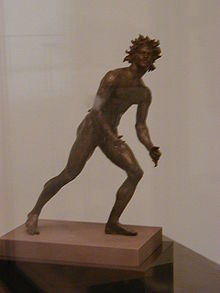- Mahdia shipwreck
-
Bronze satyr (height 0.35m) from the Mahdia shipwreck (Musée National du Bardo, Tunis.)

The shipwreck of Mahdia was found by sponge fishermen off the coast of Tunisia in June 1907.[1] The shipwreck near the modern town of Mahdia is dated about the 80s BC,[2] or even later.[3]
In a series of underwater campaigns a large number of items were recovered and placed on display at the Musée National du Bardo, Tunis. The greater part of the sculptures were salvaged between 1907 and 1913 by French archaeologist Alfred Merlin, at that time Director of Antiquities in the Protectorate of Tunisia.[4][5] Further survey work on the site was done by a team led by Mensun Bound, but unfortunately no further excavations have been possible.
Contents
Cargo
The ship was presumably driven by a storm onto the north African coast en route from Piraeus, the port of Athens, to Italy, as it was carrying Greek works of art intended for Roman purchasers, marble and bronze sculptures, high-quality furniture fittings, decorative items and architectural elements. These were later restored by researchers from the Rheinisches Landesmuseum Bonn in Germany. There were also several dozen heavy marble columns and parts of catapults.
It has been generally thought that the marble columns were removed and shipped by order of Lucius Cornelius Sulla after his sacking of Athens in 86 BC. None of the epic-scaled Homeric figures that gained popularity in the 1st century BC were to be found, nor any copies of Classical works of the 5th century, as Nikolaus Himmelmann pointed out, contrasting the Mahdia cargo with the similar cargo of the somewhat later Antikythera ship.[6] Recovered were a marble bust probably of Ariadne, two large-scale bronzes, a herm figure of a turbaned Dionysus, inscribed with the name of its maker, Boëthos of Chalcedon,[7] and a lithe, winged olive-wreathed boy, identified by scholars as Agon or Eros Enagonios, Eros as lord of contests, a bronze bust of Ariadne, and two bronze statuettes of dancing dwarfs.[4]
Among five smaller bronzes, found at the site in 1910,[8] was the satyr illustrated at right. The site also contained lead objects, including anchors, tubes and plates,[9] and ingots that, according to their isotope-composition, seem to come from the Sierra de Cartagena in Spain.
See also
References
- ^ Reported by Alfred Merlin, in Bulletin de la société nationale des antiquaires de France 1908:128-131 (noted by William N. Bates, "Archaeological News", American Journal of Archaeology 13.1 (January - March 1909), p 102f; a more complete catalogue is Werner Fuchs, Der Schiffsfund von Mahdia (Tübingen:Wasmuth) 1963; Fuchs' attribution of the assemblage to the workshop of Boëthius was resisted, e.g., by Jean Charbonneaux, extensively reviewing Fuchs 1963 in Gnomon 37.5 (September 1965:523-526).
- ^ Date based on the associated ceramics, late second century — 86 BCE (Thompson group E (Fuchs 1963).
- ^ "Recent research has tended to lower the date of the Mahdia ship's final trip (perhaps as far down as 60)", observes Brunilde Sismondo Ridgway (Ridgway, Hellenistic Sculpture: The styles of ca. 100-31 B.C p. 2002, p. 69).
- ^ a b Faqs.org
- ^ http://www.tunisiaproduction.com/
- ^ Himmelmann 1995, noted in Ridgway 2002.
- ^ Boëthos, mentioned in Pliny, was a second-century BC sculptor, according to Carol C. Mattusch, "Two Bronze Herms: Questions of Mass Production in Antiquity" Art Journal 54.2, Conservation and Art History (Summer 1995:53-59) p. 55; the other herm, based on the same model, was purchased by the J. Paul Getty Museum in 1979 (acc. no. 79.AB.138).
- ^ William N. Bates, "Archaeological News" American Journal of Archaeology 15.1 (January - March 1911:77-129) p. 113: an Eros holding a cithara (illustrated), two women dancing to castanets, a clown, a seated actor and the satyr.
- ^ Hartmut Kutzke, Bruno Barbier, Petra Becker and Gerhard Eggert, "Barstowite as a corrosion product on a lead object from the Mahdia Shipwreck", Studies in Conservation 42.3 (1997:176-180).
Further reading
- Werner Fuchs, Der Schiffsfund von Mahdia (Tübingen, 1963)
- G. Hellenkemper-Salies et al., (eds.), Das Wrack. Der antike Schiffsfund von Mahdia (Cologne 1994).
Categories:- History of Tunisia
- Shipwrecks in the Mediterranean
- Archaeology of shipwrecks
Wikimedia Foundation. 2010.

